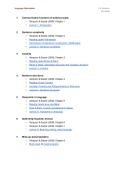Language Optimization C.S. Bootsma
S5314895
1. Communicative functions of sentence types
○ Verspoor & Sauter (2000) Chapter 1
○ Lecture 1: Introduction
2. Sentence complexity
○ Verspoor & Sauter (2000) Chapter 2
○ Reading guide Fahnestock
○ Fahnestock C8 Sentence Construction: Modification
○ Lecture 2: Sentence complexity
3. Linearity
○ Verspoor & Sauter (2000) Chapter 3
○ Reading guide Birner & Ward
○ Birner & Ward: Information structure and Syntactic structure
○ Lecture 3: Linearity
4. Sentence structures
○ Verspoor & Sauter (2000) Chapter 4
○ Reading Guide Cornelis
○ Cornelis: Framing and Perspectivising in Discourse
○ Lecture 4: Sentence structures
5. Viewpoints in language
○ Verspoor & Sauter (2000) Chapter 5
○ Reading Guide Gray and Biber
○ Gray & Biber: Current conceptions of stance
○ Lecture 5: Viewpoints in language
6. Optimizing linguistic choices
○ Verspoor & Sauter (2000) Chapter 6
○ Verspoor & Sauter (2000) Chapter 7
○ Lecture 6: Meaning-making using language
7. Wrap-up and preparation
○ Verspoor & Sauter (2000) Chapter 8
○ Mock exam & model answers
,INDEX
1. Communicative functions of sentence types 3
1.1. Verspoor & Sauter (2000) Chapter 1 3
1.2 Declarative, interrogative, imperative and exclamatory sentence patterns 3
1.3 Participant, process, attributes, and setting 3
1.4 Subject, predicator, object, attribute, and adverbial 4
1.5 Typical sentence patterns 5
1.7 English word order 6
1.2. Lecture 1: Introduction 8
Morphological negation versus sentence negation 8
Prosody vs orthography 8
Summary 1. Communicative functions of sentence types 8
2. Sentence complexity 9
2.1. Verspoor & Sauter (2000) Chapter 2 9
Sentences versus clauses 9
Types of clauses 10
The difference between a coordinating conjunction and a conjunctive adverb 11
Sentence types 11
4. Compound-complex sentences 11
Modifcation 12
2.2. Reading guide Fahnestock 13
2.3. Fahnestock C8 Sentence Construction: Modification 13
Independent/main clauses Meaningfull by themselves 13
Dependent/subordiante clause Cannot strand on their own, start with a subordinate 13
1. Types of (dependent?) clauses 14
b. Adjective clauses 14
2.4. Lecture 2: Sentence complexity 16
LO perspectives 16
How to identify, and analyse 16
Sentences versus clauses 16
Types of sentences 16
Types of clauses 17
3. Linearity 18
3.1. Verspoor & Sauter (2000) Chapter 3 18
3.2. Reading guide Birner & Ward 18
3.3. Birner & Ward: Information structure and Syntactic structure 18
3.4. Lecture 3: Linearity 18
4. Sentence structures 19
4.1. Verspoor & Sauter (2000) Chapter 4 19
4.2. Cornelis: Framing and Perspectivising in Discourse 19
4.3. Reading Guide Cornelis 19
1
, 4.4. Lecture 4: Sentence structures 19
5. Viewpoint in language 20
5.1. Verspoor & Sauter (2000) Chapter 5 20
5.2. Reading Guide Gray and Biber 20
5.3. Gray & Biber: Current conceptions of stance 20
5.4. Lecture 5: Viewpoints in language 20
6. Optimizing linguistic choices 21
6.1. Verspoor & Sauter (2000) Chapter 6 21
6.2. Verspoor & Sauter (2000) Chapter 7 21
6.3. Lecture 6: Meaning-making using language 21
7. Wrap up and preparation 22
7.1. Verspoor & Sauter (2000) Chapter 8 22
7.2. Mock exam & model answers 22
2
, 1. Communicative functions of sentence types
1.1.Verspoor & Sauter (2000) Chapter 1
1.2 Declarative, interrogative, imperative and exclamatory sentence patterns
When people communicate, they do so for various reasons. The main reasons are:
1. To inform someone of something
2. To get information from someone
3. To get someone to do something
4. To express one’s attitude about something
1. Inform John is leaving Subject-whole verb Declarative
2. To get Is John leaving? Part of verb-subject-rest of verb Interrogative
information
3. To get someone Leave! Verb by itself Imperative
to do something
4. Express one's How awful John is How__of What a __ followed by the Exclamatory
attitude leaving! remainder of the sentence
Most sentences are informative and will have the declarative sentence pattern.
1.3 Participant, process, attributes, and setting
When we look at a picture, we can name the following aspects: one or more participants,
attributes of these participants, and information
about the setting or the event or situation. In a
typical sentence, the person or thing that stands
out the most is named first. We will call this
person or thing the first participant. Followed
by the process, like walking or talking. Then,
the speaker may say something about the first
participant or name other participants. These
are attributes describing a quality or
characteristic.
3





